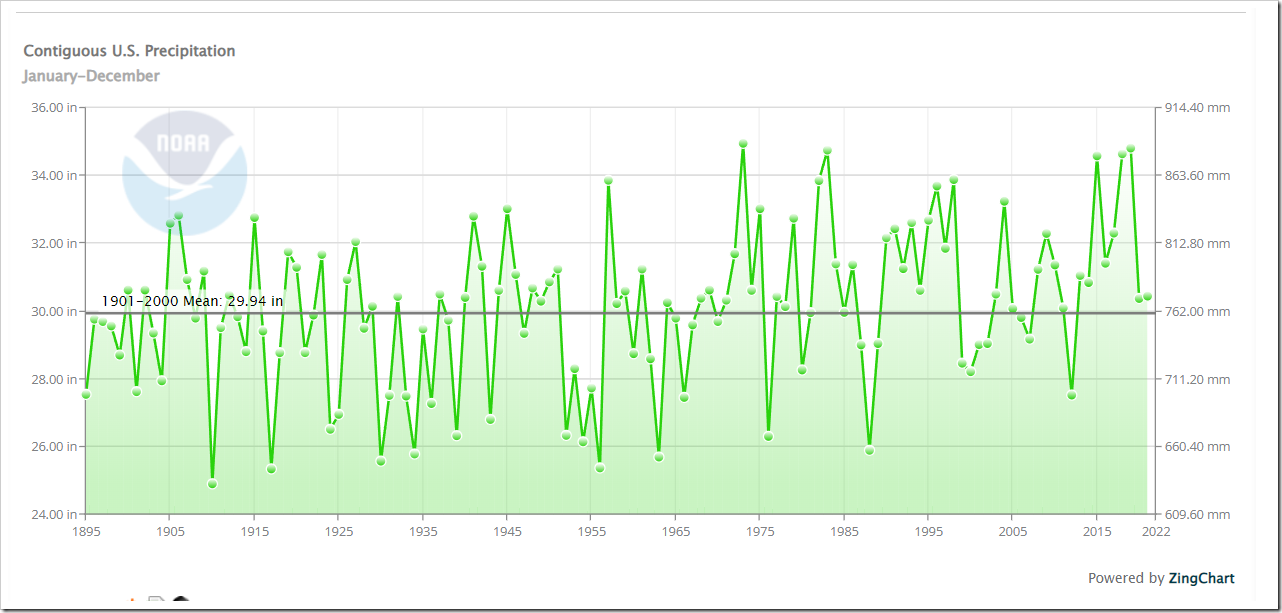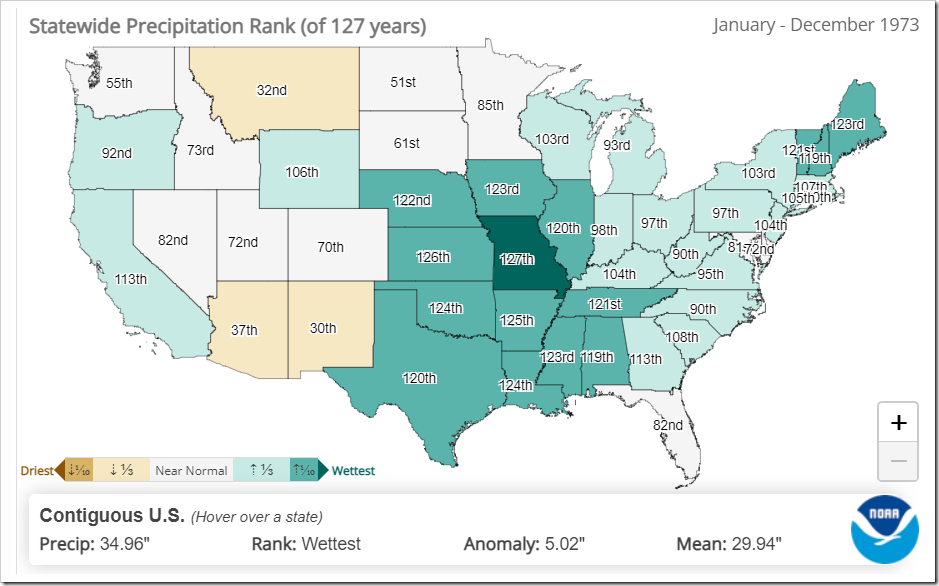Coldest, Wettest & Stormiest – The Good Old Days Before Global Warming
By Paul Homewood
By the 1970’s, the Earth had experienced three decades of declining temperatures, which Hubert Lamb described as “longest-continued downward trend since temperature records began”.
Many will be aware that the coldest winter on record in the US was that of 1978/79, more than 1F colder than any other year.
It is also common knowledge that the 1970’s suffered the most from tornadoes.

What may less well known, though, is that the US also had its wettest year on record during the decade, in 1973.
Very few parts of the country escaped the rain, and the east and central regions suffered particularly hard:
http://gis.ncdc.noaa.gov/map/cag/#app=cdo
Unsurprisingly, severe flooding resulted. The most notable was the Mississippi Flood between March and May, rated as the second worst ever after 1927’s.

Morgan City, LA – May 1973
But the Tennessee Valley also suffered one of its costliest floods in modern history.

Flooding along Huntsville Spring Branch and Memorial Parkway on March 16, 1973.
Later, in October, an intense thunderstorm produced the greatest urban rainfall on record in Oklahoma, with accumulations of 15 to 20” within a 100 sq mile area. Nine people died in the resultant floods in Enid, OK

Enid, Oklahoma
And there was a major flood of the South Platte River in Denver, described in 2003 as “the last big flood in Denver”.
http://pubs.usgs.gov/circ/1973/0689/report.pdf
But there were many, many more floods that year, as the USGS report:
Summary of Significant Floods, 1970 Through 1989, by Year
1973
Moderate to severe flooding occurred along the central coast of California in January 1973 . Numerous small drainages scattered along about 300 mi of coastline had the largest discharges of record. Large flows were confined to drainages of less than 60 mi² and occurred mostly in drainage areas of less than 10 mi².
Much of the eastern half of the United States had above-average rainfall in March. Severe floods occurred March 7-9 and 15-16, with streamflow remaining high between the two flood periods in several streams in central Wisconsin. Rainfall on March 17-19 caused severe flooding from western Virginia to southwestern Mississippi. Maximum discharges at more than 100 streamflow-gaging stations in Tennessee and northern parts of Mississippi, Alabama, and Georgia were greater than the previous maximum of record. The discharge at one gaging station on the Tennessee River in Alabama was the largest since at least 1867. The storms that caused this flooding were widespread over much of the area east of the Mississippi River. Strong winds associated with the storms caused severe flooding along the shores of the Great Lakes with damage in Michigan, Ohio, and New York.
In addition to the floods discussed above, the Northeast had floods from April 24 to May 3, June 30 to July 5, and August 2. The April-May floods led to Federal disaster declarations for four counties in extreme northeastern Maine. During the May-June floods, 40 counties spread over New Hampshire, Vermont, New York, and Pennsylvania were declared eligible for Federal disaster aid. Flooding was especially severe in the Delaware River and Lake Ontario Basins. The August 2 flood was described at the time as the most deadly one in the history of central New Jersey, with six deaths recorded.
Spring floods along the Mississippi River resulted in disaster declarations for every county bordering the Mississippi River from the Wisconsin-Illinois State line to the mouth of the river in Louisiana. Floods that began on the Mississippi River and its tributaries in early March lasted through June and caused the evacuation of 50,000 people and damages of more than $400 million. New records for consecutive days above flood stage were set, and maximum stages and discharges exceeded the estimated 100-year recurrence intervals (Chin and others, 1975).
A significant regional flood in the Western States during 1973 resulted from the melting of excessive snowpack in the Rocky Mountains. The highwater period began in April in Arizona and extended through June in Wyoming. Extreme flooding occurred along the South Platte River in Colorado and Nebraska, both from rain on snow and from a general warm-weather snowmelt. The general snowmelt produced significant flooding in the headwaters of the Rio Grande in central Colorado and New Mexico and in the Green River and Colorado River Basins of Wyoming, Colorado, and Utah.
Several floods occurred in April, May, June, September, and November in Southern States from the Carolinas to Mississippi. Primary areas and dates of flooding were March 30-April 8 near the Georgia-Florida State line, May 27-29 in the southern Appalachian area, and June 5-6 near Atlanta, Georgia. Floods occurred near the boundary between North and South Carolina during September 13-14, and in Kentucky and Tennessee during November 25-28.
Multiple floods occurred in an arc through parts of Texas, Oklahoma, Arkansas, Kansas, and Missouri during 1973. Some streams flooded several times during the year. Widespread flooding occurred in the lower parts of the Missouri, White, Arkansas, Yazoo, and Red River Basins. Flooding occurred in basins throughout much of Texas at the time of the March-April floods along the Mississippi River. Discharges in tributaries to the Mississippi River were not historic maximums, but their combined flows caused flooding on the main stem of the Mississippi River. Widespread flooding also occurred in Texas in June and July. The July floods affected the San Antonio, Guadalupe, and Frio River Basins and a small part of the Rio Grande Basin.
Some streams reached the highest stages since the mid-1800’s. Other periods of significant flooding occurred in the Texas-Missouri arc from late September through mid-October and in late November. Flood crests occurred mainly during September 26-29, October 11-13, and November 24-26, but small areas had flooding on other dates, especially September 5-7 and September 12-14. At numerous streamflow-gaging stations, discharges during late September and mid-October floods ranked highest or second highest in many years of record; at others, the November discharge was larger.
Bring back that global cooling!!
Comments are closed.




Well OK, then, but how did they manage more than 1F colder than any other year ? But all that stuff doesn’t bother me up or down – just that Control Freaks Jobsworths DO AFFECT what I want to do, way out in the Countryside.
And By Jingo it is cold here in N of ( Mainland) Scotland again today. The Arctic & other pole is melting (?) so where is all this cold coming from? and likewise in middle of Winter, we can have warmer Days & NIGHTS ( without Sunshine) than at this time of year with already 13 hours available Sunshine ( above the clouds )
A global average temperature is an absurd and meaningless figure even if it wasn’t the product of wilful fudgery. Don’t take my word for it read what the likes of Physics Nobel Lauriat Ivar Giaever had to say about it.
Like everything else Klymutt sheyngshe, those who wish us harm have created a fantasy land of oversimplified tosh suitable for the consumption of soft brained individuals of Al Gore’s intellectual level or below. Simple factually unsupported (false) claims such as human caused planet wide temperature increase and simple factually unsupported (false) temperature control knobs, i.e. CO2.
Klymutt sheyngshe !! Ha ha! Helmutt & Olaf ‘s Relation. When I see Olaf on the go, I immediately think of that comedy strips with Schultz
Whatever happened to the April ‘heatwave’ – aka a few warm days in April. Monday morning it chucked it down and turned to hail. On Tuesday working out on Kenley Downs the wind was bitter especially when the sun went in and even more so when a squally shower with hail came across. It just started another one when I was leaving and it was quite a sight to see it across Caterham Valley from just outside the hail.
Weather used to be a topic of somewhat boring conversation but now…it’s a vehicle for out and out BS and propaganda. The latest dose of dross from the BBC
https://www.bbc.co.uk/news/science-environment-68835575
Apparantly it is now the hottest evah as “Temperatures soared above 48C”
(Can’t the BBC journos figure out their keyboards for symbols like this ° !)
Except it is not anything like a record.
https://www.plantmaps.com/en/ml/climate/extremes/c/mali-record-high-low-temperatures
Love the way they highlight deaths of over 60s. How many Mali residents lived that long 50 years ago? (The population has quadrupled over the last 50 years)
“Nine things people often overlook when they move to France | Frost warnings, storms – and snow are back ”
I remember ice flows on the river Tyne passing under the bridges in Newcastle in the 70’s
It is bloody cold in North Yorkshire today, coupled with yet more rain, thank God for the risk of Global Warming, just, can it happen quicker.
Another big eruption, Ruang volcano gone up spewing many tons of material into the atmosphere on top of Hunga Tonga putting millions of tons of water vapour into the stratosphere two years back, so god knows what the long term effect on the weather will be.
I guess all that water vapour is dropping back currently ?
But we can be sure the Witch Doctors will be shaking their climate sticks as us.
Maybe Prof. Pfizer will come out with a ‘safe & effective’ tonic to combat its effects :) (which I wont be taking like the last lot of snake oil thank god)
Amazing how many people have been fooled by the Hunga Tonga water vapour amount.
If it were all to fall as rain on one day over the UK only it would only amount to 25mm (around an inch).
If it were spread more globally, the UK only covers 1/2000 of the globe and over a period of a year or so? Literally a drop in the ocean.
I wondered when “common sense” would prevail ???!!!
In 1947 the coldest ever temperature recorded temperature in Kent was −21.3 °C . This reading was taken at the official Met Office (rural) station of Elmstone. Other cold temperatures in Kent have been recorded over the years at Charing (rural ), Anvil Green (rural), Eynsford (rural), Acrise (rural) and Pluckley (rural). What do all these official Met Office sites have in common apart from recording cold temperatures…..they are all rural not being affected by urbanisation AND they are no longer there.
It is quite apparent that (in Kent at least as far as I can ascertain so far) the rural stations have largely been closed down and mostly those in urban areas retained. Whether or not this was a deliberate ploy or an inadvertent effect of other operational reason is open to question….so I have asked the Met Office for an explanation.